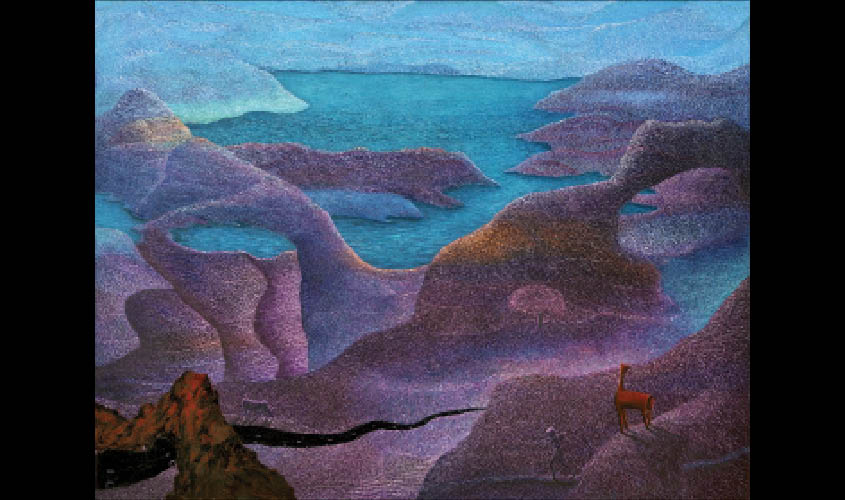The city of Baroda has been the nurturing ground for some of the greatest Indian modernists. But even when it comes to contemporary art, Baroda has become an important creative hub, as a new exhibition demonstrates, writes Bhumika Popli.
The Baroda March, an exhibition currently on view at Delhi’s Stainless Gallery, features more than 100 artworks by as many as 43 artists from Baroda, the city that gave us luminaries such as K.G. Subramanyan and Gulam Mohammed Sheikh.
The show is organised by Bombay’s Rukshaan Art Gallery and comprises paintings, sculptures, prints and new-media works. The aim of this exhibition is to highlight works by artists who have either studied fine arts at the Maharaja Sayajirao University of Baroda (MSU), or those who chose to make the city their home in order to nurture their creative talents.
Sonu Aggarwal, originally from Jammu, belongs to the latter set of artists. Her two bronze works—Couple on the Couch and Lady Looking in the Mirror—are included in the show, and both are explorations of domestic themes.
Though the artist completed her formal education at Santiniketan, she always wanted to study at the MSU. “During my graduation in Jammu, my teachers inspired us to take up further studies in Baroda and hence it became a dream place for me. But the entrance result of Santiniketan, which I had cleared, was announced earlier than the one at MSU. At the same time, someone stole my Rs 10,000. It was 1999 and that amount was huge for me. I was called for an interview at Baroda but I couldn’t go. I was stressed and just decided to go ahead with my admission at Santiniketan and didn’t feel like waiting for another result. The theft affected me big time, otherwise I would have been at the MSU,” says Aggarwal.
But Aggarwal was destined to return to Baroda. She got married to an artist who studied at the MSU. The couple shifted to Baroda, which became a second home for the artist.

Baroda’s MSU has remained one of the top choices for those looking to expand their artistic horizons. The university’s art faculty has produced veterans like Gulam Mohammed Sheikh, Nasreen Mohammedi and Laxma Goud among other stalwarts who elevated the Indian art scene to new levels. The Baroda Group—a significant collective of artists which included doyens like Jyoti Bhatt, N.S. Bendre, K.G. Subramanayan and many more—is also respected worldwide for its genre-breaking achievements.
The MSU gained its university status in 1949 and its arts faculty came into being the following year. But Baroda’s history of art goes way back to 1881. In this year, the College of Science—what is now the MSU—was founded. At the same time, Maharaja Sayajirao Gaekwad III invited the well-known painter Raja Ravi Varma to Baroda. Varma produced a considerable quantity of works here, which are now on display at the Baroda Museum, located across the road from the university.
Rukshaan Krishna, curator of the show, was led to Baroda through the paintings of Ambu Rathwa, which she saw at a Bombay exhibition. “I saw Rathwa’s works in Bombay at an exhibition which displayed exhibits by the recipients of Inlaks scholarship. Rathwa [whose works are included in the show] used fantastical elements on the canvas. His paintings are based on his dreams. When I visited the city I found it quite welcoming and that’s one of the reasons I am able to have this particular show uninterrupted, every year, from the past 12 years,” says Krishna.

Girjesh Kumar Singh from Uttar Pradesh, among the participants in the show, also found the city so welcoming that he decided to stay back even after completing his master’s in 2006 from the MSU. “I have been here for 14 years. All my life, I have been migrating from one place to another but now I feel I have settled here. This is a great place to be an artist. You are in touch with your fellow artists and teachers. And you also learn many things from the city. You see structures being demolished, you think about the phenomena of the old and the new. Without any deliberate effort, these elements bring me face to face with my own journey as I have been migrating from one place to another.” says the artist.
Singh’s small-scale sculptures on display at the show are themed on migration. He has used bricks from demolished old houses and made scaled-down buildings, like architectural models of old buildings in Baroda. These are part of his series entitled Often, I Find Myself Brick and Mortar.
“If you closely look at the broken brick pieces you observe mortar being stuck to the bricks. This facet of broken houses allowed me to use mortar as a metaphor to represent memories of a place that stays with you subconsciously,” says Singh.
Deepa Varan’s watercolours also add to the architectural dimension of this exhibition. In her paintings, one could see arches, domes, gates, and other elements of buildings coming together in a circular shape. “I feel everything is connected through the cosmopolitan culture of this city,” says Varan.
The Baroda March organised by Rukshaan Art Gallery, in collaboration with Lightbox, is on view at Stainless Gallery, Delhi till 17 March

